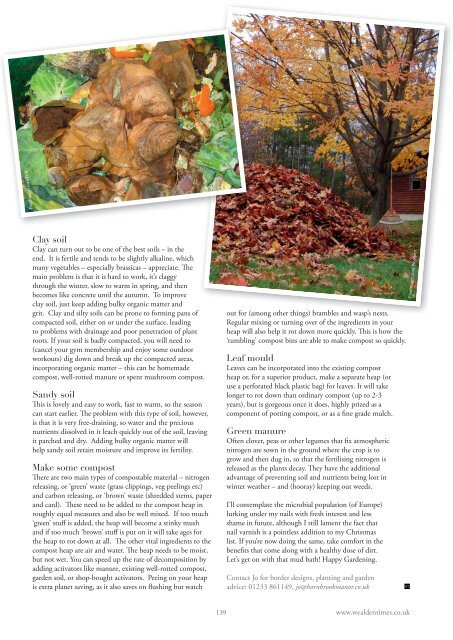Wealden Times | WT166 | December 2015 | Interiors supplement inside
Wealden Times - The lifestyle magazine for the Weald
Wealden Times - The lifestyle magazine for the Weald
You also want an ePaper? Increase the reach of your titles
YUMPU automatically turns print PDFs into web optimized ePapers that Google loves.
FreeImages.com/B.B<br />
Clay soil<br />
Clay can turn out to be one of the best soils – in the<br />
end. It is fertile and tends to be slightly alkaline, which<br />
many vegetables – especially brassicas – appreciate. The<br />
main problem is that it is hard to work, it’s claggy<br />
through the winter, slow to warm in spring, and then<br />
becomes like concrete until the autumn. To improve<br />
clay soil, just keep adding bulky organic matter and<br />
grit. Clay and silty soils can be prone to forming pans of<br />
compacted soil, either on or under the surface, leading<br />
to problems with drainage and poor penetration of plant<br />
roots. If your soil is badly compacted, you will need to<br />
(cancel your gym membership and enjoy some outdoor<br />
workouts) dig down and break up the compacted areas,<br />
incorporating organic matter – this can be homemade<br />
compost, well-rotted manure or spent mushroom compost.<br />
Sandy soil<br />
This is lovely and easy to work, fast to warm, so the season<br />
can start earlier. The problem with this type of soil, however,<br />
is that it is very free-draining, so water and the precious<br />
nutrients dissolved in it leach quickly out of the soil, leaving<br />
it parched and dry. Adding bulky organic matter will<br />
help sandy soil retain moisture and improve its fertility.<br />
Make some compost<br />
There are two main types of compostable material – nitrogen<br />
releasing, or ‘green’ waste (grass clippings, veg peelings etc)<br />
and carbon releasing, or ‘brown’ waste (shredded stems, paper<br />
and card). These need to be added to the compost heap in<br />
roughly equal measures and also be well mixed. If too much<br />
‘green’ stuff is added, the heap will become a stinky mush<br />
and if too much ‘brown’ stuff is put on it will take ages for<br />
the heap to rot down at all. The other vital ingredients to the<br />
compost heap are air and water. The heap needs to be moist,<br />
but not wet. You can speed up the rate of decomposition by<br />
adding activators like manure, existing well-rotted compost,<br />
garden soil, or shop-bought activators. Peeing on your heap<br />
is extra planet saving, as it also saves on flushing but watch<br />
out for (among other things) brambles and wasp’s nests.<br />
Regular mixing or turning over of the ingredients in your<br />
heap will also help it rot down more quickly. This is how the<br />
‘tumbling’ compost bins are able to make compost so quickly.<br />
Leaf mould<br />
Leaves can be incorporated into the existing compost<br />
heap or, for a superior product, make a separate heap (or<br />
use a perforated black plastic bag) for leaves. It will take<br />
longer to rot down than ordinary compost (up to 2-3<br />
years), but is gorgeous once it does, highly prized as a<br />
component of potting compost, or as a fine grade mulch.<br />
Green manure<br />
Often clover, peas or other legumes that fix atmospheric<br />
nitrogen are sown in the ground where the crop is to<br />
grow and then dug in, so that the fertilising nitrogen is<br />
released as the plants decay. They have the additional<br />
advantage of preventing soil and nutrients being lost in<br />
winter weather – and (hooray) keeping out weeds.<br />
I’ll contemplate the microbial population (of Europe)<br />
lurking under my nails with fresh interest and less<br />
shame in future, although I still lament the fact that<br />
nail varnish is a pointless addition to my Christmas<br />
list. If you’re now doing the same, take comfort in the<br />
benefits that come along with a healthy dose of dirt.<br />
Let’s get on with that mud bath! Happy Gardening.<br />
Contact Jo for border designs, planting and garden<br />
advice: 01233 861149, jo@hornbrookmanor.co.uk<br />
FreeImages.com/Woolpert<br />
139 www.wealdentimes.co.uk


















